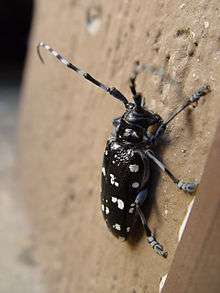Anoplophora
Anoplophora is a genus of beetles in the longhorn beetle family (Cerambycidae). They are native to Asia.[1] Most are large and colorful and thus are depicted in artwork and sought after by beetle collectors.[2] The genus also includes several notorious pest insects.[1]
| Anoplophora | |
|---|---|
 | |
| Anoplophora chinensis | |
| Scientific classification | |
| Kingdom: | Animalia |
| Phylum: | Arthropoda |
| Class: | Insecta |
| Order: | Coleoptera |
| Family: | Cerambycidae |
| Subfamily: | Lamiinae |
| Tribe: | Lamiini |
| Genus: | Anoplophora Hope, 1839 |
| Species | |
|
see text | |
| Wikimedia Commons has media related to Anoplophora. |
Description
Beetles of Anoplophora are 1 to 5 centimeters in length. They are spotted or banded with a range of color patterns in shades of yellow, blue, purple, and white.[2] They have very long antennae.[1] One characteristic that is particularly useful for distinguishing the species from one another is the structure of the male genitalia.[3]
Impacts
Several Anoplophora species are major pests of urban, ornamental, and agricultural trees.
The Asian long-horned beetle (A. glabripennis) is native to China and Korea,[2] and it is now widespread in Europe as an introduced species. Populations of this beetle have been detected in some locations in North America, including Toronto, Chicago, New Jersey, Ohio, Massachusetts, and New York City, and have either been declared eradicated, or are currently being dealt with under an eradication program. Many tree species can serve as hosts to the beetle, but it especially favors maples.[4]
The citrus long-horned beetle (A. chinensis syn. A. malasiaca) has been introduced from Asia to Europe and North America. It is a pest of citrus and other fruit and nut trees. It infests forest trees and ornamentals. It attacks over 100 species of trees, shrubs, and herbs from many plant families. Damage from its wood-boring larvae can kill trees.[1]
Diversity
In a 2002 revision of the genus, 36 species were recognized.[2] At least one more species has been described since then.[5]
Species include:[6]
- Anoplophora beryllina[7]
- Anoplophora cheni
- Anoplophora chinensis - citrus long-horned beetle[8]
- Anoplophora davidis
- Anoplophora elegans
- Anoplophora flavomaculata
- Anoplophora freyi
- Anoplophora glabripennis - Asian long-horned beetle
- Anoplophora granata
- Anoplophora horsfieldi
- Anoplophora lurida
- Anoplophora macularia
- Anoplophora medenbachii
- Anoplophora quadrifasciata
- Anoplophora rubidacorpora[5]
- Anoplophora sollii
- Anoplophora stanleyana
References
- McDougall, D. N. Anoplophora chinensis. USDA Forest Service, State and Private Forestry. North American Forest Commission Exotic Forest Pest Information System (NAFC-ExFor). 2001.
- Hoebeke, E. R. and G. Page. (2002). Longhorned beetles of the genus Anoplophora and lithography: Alien invaders in the eye of the beholder! Archived 2010-12-16 at the Wayback Machine American Entomologist 48(4) 200-06.
- Wu, W. and S. Jiang. (1989). A taxonomic study of the male genitalia of the genus Anoplophora Hope (Col. Cerambycidae). Acta Entomologica Sinica 2, 012.
- Smith, M. T., et al. (2009). Asian longhorned beetle Anoplophora glabripennis (Motschulsky): Lessons learned and opportunities to improve the process of eradication and management. American Entomologist 55(1) 21-26.
- Xie, G. L., et al. (2012). An unusual new species of Anoplophora Hope, 1839 (Coleoptera: Cerambycidae) from Guizhou, China. Archived October 20, 2013, at the Wayback Machine Far Eastern Entomologist (248) 1-4.
- Old World Monochamini.
Further reading
- Lingafelter, S. W. and E. R. Hoebeke. Revision of Anoplophora (Coleoptera: Cerambycidae). The Entomological Society of Washington, Washington, D.C. 2002. 238 p.